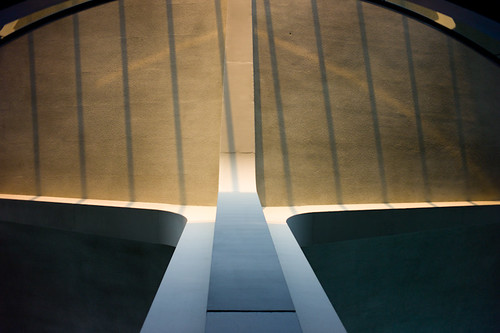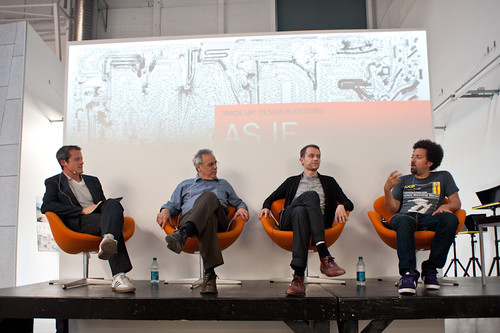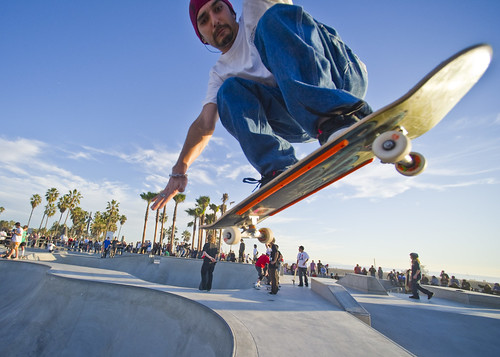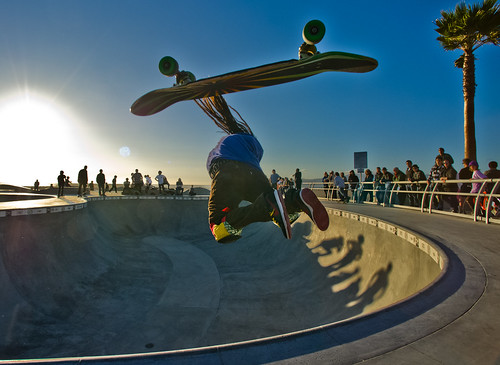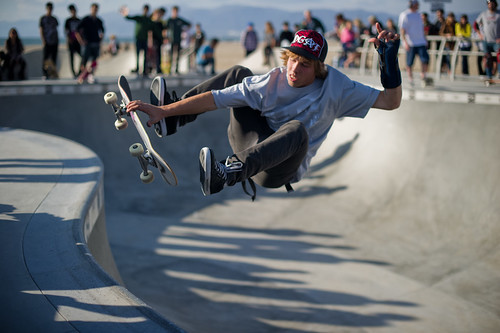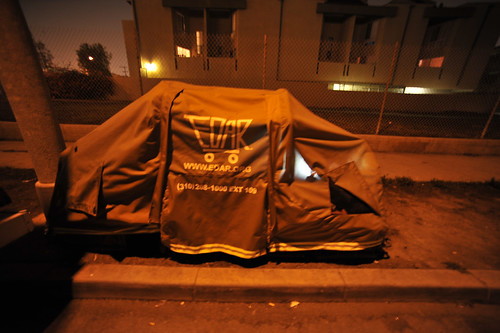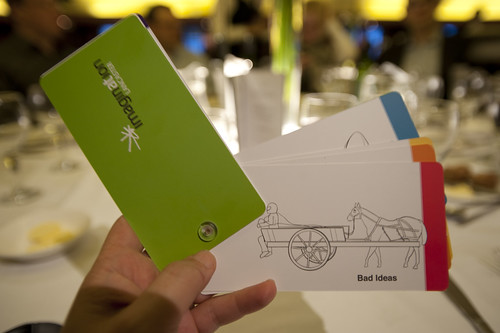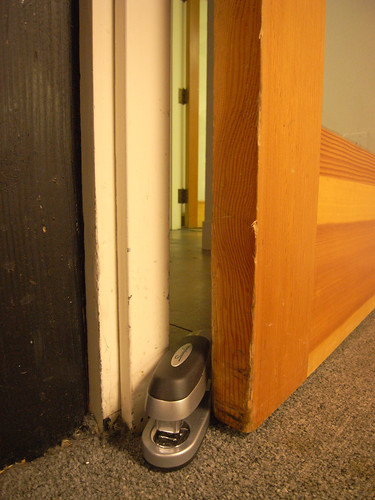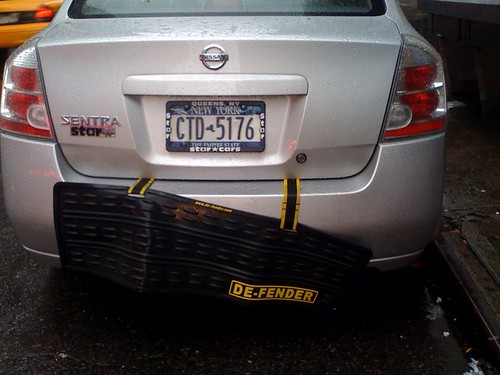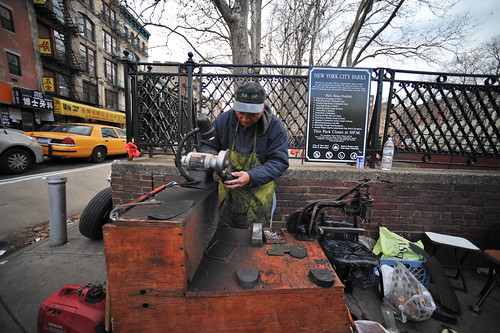A view from the bottom while transiting through Newark International Airport last week..or two weeks ago. Fuzzy on that. A visit home and then to see some friends and do some touring around Massachusetts and New Hampshire, which reminds me that the American North East can be lovely to visit. Um..take my word for it even if I just share an architectural photograph of the airport..
Continue reading Superstructures
Category: Photo
Weekending 09192010
Okay. There was some more fussing about to pull together a reading list / viewing list for a new project I’ve been thinking about that is in and around augmented reality. The viewing list includes the usual suspects — Terminator 2, They Live (which I showed in the studio — and only three or four people showed up to, which is lame), Until the End of the World, Iron Man, and 2081, although that last one may be a stretch. There may also be some of the important “boot-up” moments from RoboCop that are relevant.The point is to look sideways at the topic from the get-go and not assume the outcome before things get started, which can happen very easily when the project is quite specific. ((It’s not broad at all — as a matter of fact, the name basically says what it wants to produce, which is the wrong way to do any project, I think.))
I scrambled over to Art Center College of Design Friday afternoon to participate in their As If.. / Made Up research residency on a panel discussion with Norman Klein and Sascha Pohflepp, which was good fun and engaging and helpful for my own questions. I think I’m now more-or-less set on creating a catalog of genre conventions for design fiction, especially as it happens in film. Getting a copy of that book “Cinematic Storytelling: The 100 Most Powerful Film Conventions Every Filmmaker Must Know” (bleechh..these titles..)) made me think about how I might structure such a catalog and then of course I’m forced to think of why this might be useful. Part of it is just the process of forcing myself to identify what might be curious, useful or intriguing visual patterns and story telling techniques that make it possible to imagine the future, or some aspect of it. I was thinking this could make a curious DVD of some sort.
var so = new SWFObject(“http://www.db798.com/pictobrowser.swf”, “PictoBrowser”, “500”, “500”, “8”, “#EEEEEE”); so.addVariable(“source”, “sets”); so.addVariable(“names”, “2010 01SJ Biennial – Build Your Own World”); so.addVariable(“userName”, “julianbleecker”); so.addVariable(“userId”, “66854529@N00”); so.addVariable(“ids”, “72157625004848614”); so.addVariable(“titles”, “on”); so.addVariable(“displayNotes”, “on”); so.addVariable(“thumbAutoHide”, “off”); so.addVariable(“imageSize”, “medium”); so.addVariable(“vAlign”, “mid”); so.addVariable(“vertOffset”, “0”); so.addVariable(“colorHexVar”, “EEEEEE”); so.addVariable(“initialScale”, “off”); so.addVariable(“bgAlpha”, “90”); so.write(“PictoBrowser100921100902”);
Saturday, went up to 01SJ, ran into everyone and a barricade. It was fun, engaging a little scattered and far-flung and lonely in spots and great to see many friends and their peculiar provocative projects.
var so = new SWFObject(“http://www.db798.com/pictobrowser.swf”, “PictoBrowser”, “500”, “500”, “8”, “#EEEEEE”); so.addVariable(“source”, “sets”); so.addVariable(“names”, “Silly Girl Pirate Bowl”); so.addVariable(“userName”, “julianbleecker”); so.addVariable(“userId”, “66854529@N00”); so.addVariable(“ids”, “72157624994149716”); so.addVariable(“titles”, “on”); so.addVariable(“displayNotes”, “on”); so.addVariable(“thumbAutoHide”, “off”); so.addVariable(“imageSize”, “medium”); so.addVariable(“vAlign”, “mid”); so.addVariable(“vertOffset”, “0”); so.addVariable(“colorHexVar”, “EEEEEE”); so.addVariable(“initialScale”, “off”); so.addVariable(“bgAlpha”, “90”); so.write(“PictoBrowser100921105429”);
Closed the weekend out with a fantastic Silly Girl skate event at the secret Iguana Bowl — Pirate Bowl, for talk like a pirate day!
Continue reading Weekending 09192010
Predictably Not Quite Failing
Since the *winter holidays here in Los Angeles, which is a strange thing for an East Coast boy, especially as I hear reports of epic dumps of man-killing snow in New York City, my favorite photography spot has been the recently opened Venice Beach Skate Park and the equally awesome Venice Skatepark. I’m not a skater, nor a Sk8r, nor a photographer inclined to action-y things, but being in the mix, under threat of kicked out boards and lawless aerials
makes the park an invigorating and challenging photography playground — and quite addictive.
I don’t want to attempt a rough-shod bit of metaphor-stretching — or at least not too much — to try and rationalize sharing this *non sequitur of a post, except to say that, as pertains the last photo, I have been obsessed with these moments when something tried..fails. The failure has this curious, no-fear character to it. Trying the thing that seems impossible, over and over again. Getting closer, or moving away from the original idea and into something else, &c. It’s never a failure out right, at least as I see it through a viewfinder. There’s always something quite lovely about the moment when the board stays where it is, and the skater goes somewhere else.
Why do I blog this? *shrug.
Continue reading Predictably Not Quite Failing
Experiment With A Bird In The Air-Pump
Last visit to London, I made a quick stop at the National Gallery in London to see this for real, Joseph Wright of Darby’s “An Experiment on a Bird in the Air-Pump”, which has relevance for me from my work and interests in the history and social studies of science. This was one of those odd tourist-y moments for me, I enjoy doing the not-for-tourists activities — think “go local, go native” — rather than “seeing the sights.” Need to get over that, I suppose.
In this case, I got excited a day or two before arriving to London as I was giving a talk in Aberdeen Scotland and sought a digital image of this painting as I was preparing. When I realized the original was at the National Gallery and that I would be able to see it face-to-face, the weekend in London took an entirely new urgency.
The Air Pump was the Cyclotron of its day, in the 18th century, as best explicated by Steven Shapin and Simon Shaffer’s remarkable historical investigation of the late prehistory of modern science in Leviathan and the Air-Pump. I’m turning back to this material, especially as I hash through new thinking on the role of the “invisible” behind-the-scenes technicians of design fictions.
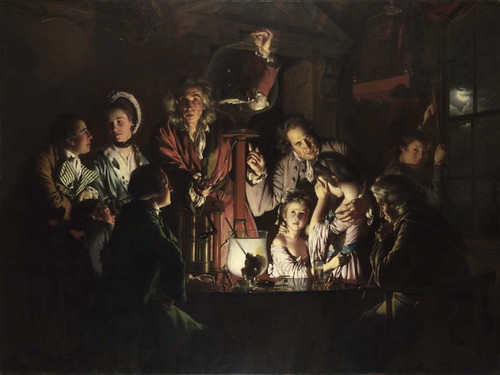
The image provides a useful backdrop with which to tell the story that Steven Shapin does of the “Invisible Technician” who does the important hand- and craftwork, placing the action of creating knowledge, or matters-of-fact or, to stitch in Bruno Latour’s considerations on these points, the matter-of-concern. Between the reified, established matter-of-fact and the speculation, or imagining of what that might be, is the craftwork of making things — this “invisible technician.”
Parenthetically, at the time I was first studying this bit of social, technical and science history, I was mostly interested in this idea of the invisible technician as a metaphor for the backstage work done within science films — mostly science fiction films — by the moment of the films’ production. I was curious how invisible technicians as described by Shapin could also be the invisible technicians who translate a very imaginary world into one that appears as actuality, as a bit of fact based in science principles. The invisible technician was the production people, mostly in my mind the special effects artisans who are able to create this representation of reality, removing the wires of production to create a truly compelling visual story about what could be. I wanted to learn about special effects as a way of creating visions of a possible world and use the visual story as a point of departure for conversations about more habitable environments. Telling stories, through images, of possible near-future worlds – that about sums up this point.
In the painting, we see the Air-Pump apparatus and its demonstration by a traveling scientist of some sort, visiting a (likely well-to-do) family to share the most recent advances of knowledge of the day. Prior to this was the hard spade work that Robert Boyle and, to a large extent, his assistants, craftsmen, artisans, etc., who had to create the necessary experimental materials to turn the fiction of a vacuum into a demonstrable fact.
As with all good knowledge work, there was perhaps more material effort — making things, enduring material failures, etc. All the things we can comfortably take for granted today were high technology at the time — the 1660s. Blowing glass to create a large containment vessel without the kinds of flaws and defects that would cause it to collapse under the pressure of the atmosphere was very much rocket science. Creating seals to keep the air from leaking was high technology for the leather smiths employed to create cocks and fittings. Etc. The painting shows the result in a fashion, as well as a tableau of the various social and cultural meanings of the absence of matter, something that had religious significance, as does most such bold adventures into the unknown.
Why do I blog this? A canonical image of the relationships amongst knowledges and their circulation, spectacle and theater. Meme propagation in the pre-history of networks, where ideas spread by presentation, in-home sharing and worn boot leather.
Continue reading Experiment With A Bird In The Air-Pump
Practice Observed: Designed For Rest And Activity
Where I live there are quite a number of transient mobile home dwellers. I don’t know quite what the history of this is — I’m intrigued and only imagine at this point. It will take a more concerted effort to discover the larger story of why many people come here with their mobile homes and trailers, park them on the side streets of Venice Beach and effectively live there like that. It’s a different category of transience and homelessness than what I have been used to in the past such as, for example Seattle, Santa Cruz, Brooklyn or Manhattan where a box and a blanket or nothing was the stock shelter.
This shelter is constructed by EDAR – Everyone Deserves A Roof – creates an easy to establish structure that has its own wheel base for mobility and transforms into a cart of sorts for collecting and recycling during the day.
Why do I blog this? Two things are going through my mind. The first is the interesting relationships between a specific geographic place or city and the kinds of shelter for homeless and mobile transients you find there. So, all of these big RVs in Venice Beach – what’s the story there? Certainly I understand that going from a nice home to a trailer is a distinct possibility for people for a whole variety of reasons, I wonder why and how Venice Beach has become the place to drive those trailers?
The other things I’m thinking about is the “new interactive city” sorts of design/urban/ubiquitous/computing discussions and how these sorts of ‘below the grid’ designs and people and practices become part of this, or do not become a part of this. Either way could be argued to be desirable or not. For instance, staying off the grid, out of the database has a complex of normative arguments that come at the question of “on or off” from all sides. Off the grid, anonymous, beyond jurisdiction, microsocialnetworked, etc., could sound quite good and intriguing. It could also provide problems, say, if one is incarcerated with no database record – you could imagine the exception algorithm for the query dumping you into a Kafkaesque swamp of detention and rendition.
In any case, these EDAR structures are intriguing to me as design artifacts that do a simple thing to pull into context the activities of their intended owners in a really simple way. I’ve seen other homeless structures done by fancy architects who wear slender flat-front trousers and flat pointy shoes and they’re shit structural dome things that glow as they become occupied, meaning to raise awareness of the homeless problem in Los Angles. Which is crap concept architecture, if only because turning the lights on like this could make it (a) difficult to get a short night’s rest after a hot day of recycling, and (b) draw attention that may not be the ultimate goal of someone who has enough to worry about without being bothered or robbed. (If anyone can get me a pointer to that project I would appreciate it. I saw it a few years ago at a talk at USC from an LA based architect to whom I apologize for my rough but passionate crit above.)
Update — I recalled who it was from USC — Electroland who designed this Urban Nomad.
Continue reading Practice Observed: Designed For Rest And Activity
Bad Idea
Design tactics from Imagination Lancaster at the Design Connexity conference dinner. Relevant to the Near Future Laboratory’s Bureau of Failures and Frack Ups.
Tipped.
Photographic recollection of an accident that happened a few minutes before I cleaned it up. In the studio, morning — reaching to my left, I knocked over my coffee which did a fairly good job of soaking a couple of things. No biggie, except that what surprised me most was the failure of my peripheral vision and proprioception, which are both usually reasonably well-tuned. It all led to a discussion about how both of this bio capabilities may be losing their resolution with all the cone-of-activity work that ends up happening amongst people like me who tend to focus their attention into small cones of activity — at screens, both big and small, but mostly fairly small, from the cell phone display up to 24 inch LCD monitors. Andrew says we should tune to see our toes whilst looking straight ahead. Watching a West Wing rerun from season one, a Secret Service agent laments not being able to recall a crucial detail seen out of her periphery after President Bartlett and his entourage are shot at. In a recent episode of The Unit, an operator torments himself nearly to death after coming to the shock-induced, near-death realization that he missed the tell-tale miniscule details of a sniper stealthily getting into position at a high window.
Why do I blog this? Observations about how we observe and intriguing possible roles that our habits play in altering capabilities. Good, bad — not really interested. Just wondering, where do our observational abilities shift toward? Do we become like the bottom, steam-vent dwelling creatures that go around blind, sensing with touch, gesture interfaces finely tuned through millennia of playing with iPhones and game controllers?
Continue reading Tipped.
Visual Design and Mitigation Strategy
A variety of rules designed to mitigate accidents and loss of limb at a local bouncy-park, for kids. And people within certain height boundaries. And people above a certain weight. And people inclined to rough play. And people who may end up tumbling or flipping. And..
Why do I blog this? Intriguing iconography and visual idioms.
Practice Observed: Secure Improvisations
Improvisation enacted to overcome a secured door that is probably the most often used in the studio, sitting near to the kitchen and coffee machines (and the sadly defunct espresso machine..) A stapler used to keep a door open helps one poor sould evades the secure RFID lock. Likely, their secure card was left on their desk or some such and the stapler provides them a momentary work-around to returning to their desk, retrieving the card and then getting back to the necessary business of fueling up on the morning caffeine.
Why do I blog this? Observing small but actions, especially around improvisation. I am curious about the way objects become practice-based activations and serve as beacons and indications of evolving materials and materialized social practices. All this and the entanglements within the many layers (morning rituals, security, barriers, identification, access, RFID, office supplies, etc.) and the entanglements amongst humans and non-human hybrids.
Mobile Defense and Chinatown Cobbler
Curious strategy for preventing bumper dings — a bumper for the bumper, you might say. It’s the Mobile De-fender. (Get it? De Fender?) You will see material like this for preventing a lower category of bump, such as a “light tap” from negotiating a tricky parallel parking job, or even the deliberate tap to inch a car up a bit to fit better in the spot. As I was the victim of an a**hole who just steady backed up way more then he had to, willfully unaware that we were behind him, lights on and about 5 meters clear of him, steaming his ridiculous enormous 80’s Cadillac while we were waiting for him to vacate his spot, probably tipsy from a pitcher of beer at the Pizzaria we were going for family dinner, I can empathize with the necessity of additional rubberized armaments to prevent these kinds of minor dings. Fortunately, there was no noticeable damage — I think bumpers are pretty well designed these days to take a 3-5 mile per hour kiss.
Related somehow is this cobbler seen in Chinatown in New York City, working on fixing some woman’s busted heel or something. How is it related to the rubber bumper bumper? I noticed his materials — recycled rubber from a full tire (on the left, along the wall running into the frame) and a scrap of rubber from a tire on the right bottom. A resourceful, resource-reusing cobbler here. Bravo, I guess.
Why do I blog this? Observations of curious human improvisational practices for preventing abuse and renewing the use of their various mobile artifacts.
Continue reading Mobile Defense and Chinatown Cobbler
